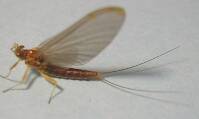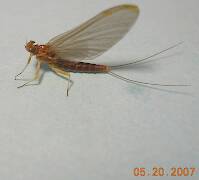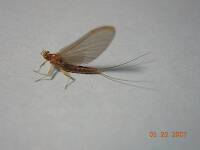
Salmonflies
Pteronarcys californica
The giant Salmonflies of the Western mountains are legendary for their proclivity to elicit consistent dry-fly action and ferocious strikes.
Featured on the forum

Nymphs of this species were fairly common in late-winter kick net samples from the upper Yakima River. Although I could not find a key to species of Zapada nymphs, a revision of the Nemouridae family by Baumann (1975) includes the following helpful sentence: "2 cervical gills on each side of midline, 1 arising inside and 1 outside of lateral cervical sclerites, usually single and elongate, sometimes constricted but with 3 or 4 branches arising beyond gill base in Zapada cinctipes." This specimen clearly has the branches and is within the range of that species.

Troutnut is a project started in 2003 by salmonid ecologist Jason "Troutnut" Neuswanger to help anglers and
fly tyers unabashedly embrace the entomological side of the sport. Learn more about Troutnut or
support the project for an enhanced experience here.

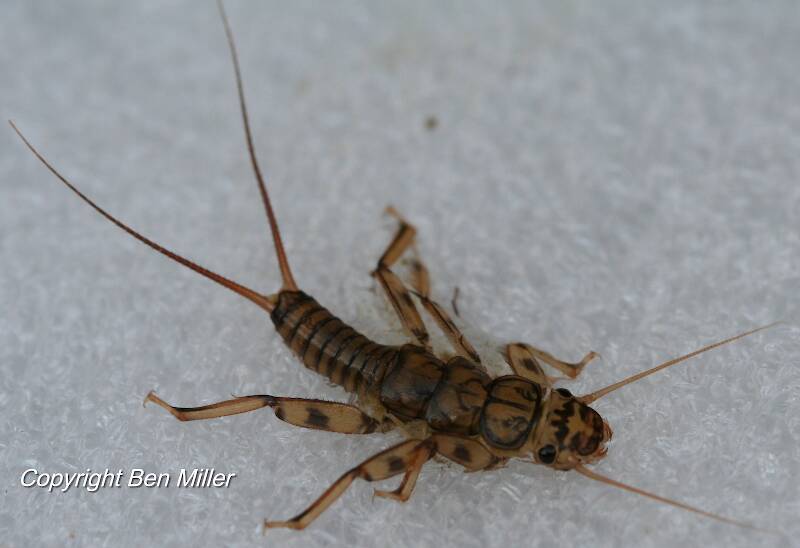
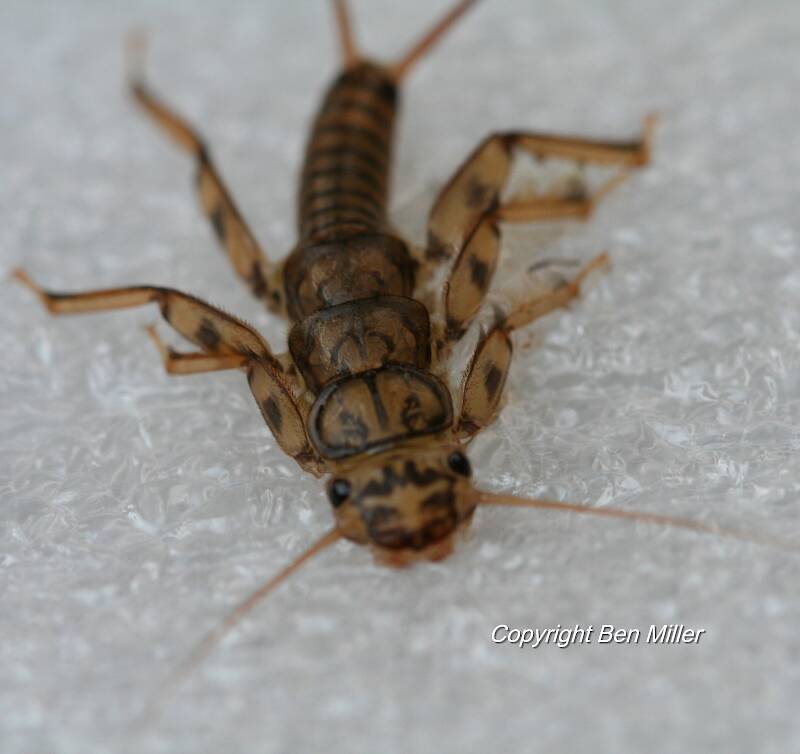
Sundula on Sep 12, 2006September 12th, 2006, 12:08 pm EDT
This one I beleive I have nailed down I just want to be sure, I have been using Jim Schollmeyer's "Hatch Guide For Western Streams" for my identification.
I'm going with:
Family: Perlodidae
Genus: Isoperla
Little Yellow Stonefly nymph (Yellow Sally), please enlighten me if I'm incorrect.
I'm going with:
Family: Perlodidae
Genus: Isoperla
Little Yellow Stonefly nymph (Yellow Sally), please enlighten me if I'm incorrect.
GONZO on Sep 12, 2006September 12th, 2006, 4:12 pm EDT
Sorry to disagree with your identification, but this appears to be an immature specimen of the Perlidae--not Perlodidae. Take heart though, you are not the first to confuse them. Both families include strongly marked black-and-yellow or brown-and-yellow nymphs. Perlodid nymphs are usually more slender and cylindrical; but the best general guidelines for distinguishing them are three words from Ken Stewart's description in Stoneflies for the Angler (Leiser and Boyle)--"gill-less," "waxy," and "non-hairy." (Some Perlodid nymphs do have simple unbranched gills, but they are not as obvious as the branched gills that project from all three thoracic segments, as in your specimen.) Rather than a "yellow sally," you have a "golden stone." I won't hazard much beyond that because I am not as familiar with the Western members of the Perlidae as I am with their Eastern relatives. I suspect that Taxon could pick up where I left off. Hope that helps.
Troutnut on Sep 12, 2006September 12th, 2006, 4:31 pm EDT
Gonzo's right -- this is Perlidae.
It's easy to tell them apart at a glance from the general shape once you've seen lots of them, but it's hard at first.
The main distinguishing characteristic you can use at first is that Perlidae nymphs have branched, filamentous gills (or "fluffy") gills on the sides/bottom of the thorax. Perlodidae and the related Chloroperlidae nymphs have either no gills there or simple non-fluffy gills.
After you've seen lots of them, the characteristics Gonzo described give it away at a glance. Perlodidae nymphs have a more clean, slender look. Start out browsing the pictures of the nymphs on my Perlidae and Perlodidae pages... that should give you a sense of the general shapes.
It's easy to tell them apart at a glance from the general shape once you've seen lots of them, but it's hard at first.
The main distinguishing characteristic you can use at first is that Perlidae nymphs have branched, filamentous gills (or "fluffy") gills on the sides/bottom of the thorax. Perlodidae and the related Chloroperlidae nymphs have either no gills there or simple non-fluffy gills.
After you've seen lots of them, the characteristics Gonzo described give it away at a glance. Perlodidae nymphs have a more clean, slender look. Start out browsing the pictures of the nymphs on my Perlidae and Perlodidae pages... that should give you a sense of the general shapes.
Jason Neuswanger, Ph.D.
Troutnut and salmonid ecologist
Troutnut and salmonid ecologist
Sundula on Sep 12, 2006September 12th, 2006, 4:55 pm EDT
Thank you both for the help,I am still very new at the specific identification of aquatic insects or any insect for that matter. I have only begun to collect them, and I value your knowledge and experience. I look forward to incorrectly identifying many more in the quest to refine my understanding of that mysterious world I find myself submerged in. Bear with me, and again thank you.
Troutnut on Sep 12, 2006September 12th, 2006, 5:58 pm EDT
Hey, that's what this site is for. :) I wouldn't have made it if everybody already knew their bugs. The whole point is to learn.
Of course, Taxon and I and the others here who "know our bugs" will be the first to tell you that there's a lot more we don't know than what we do know. That's the great thing about this sport. There's always more interesting stuff to get into and figure out.
Of course, Taxon and I and the others here who "know our bugs" will be the first to tell you that there's a lot more we don't know than what we do know. That's the great thing about this sport. There's always more interesting stuff to get into and figure out.
Jason Neuswanger, Ph.D.
Troutnut and salmonid ecologist
Troutnut and salmonid ecologist
Entoman on Apr 7, 2013April 7th, 2013, 2:39 am EDT
This is a good example (though immature) of Claassenia sabulosa. It is the only western taxon in the subfamily Perlinae, whose taxa are noted for having occipital ridges giving the back of their heads a flat or concave look. Western anglers who don't concern themselves with taxonomic fine points can easily tell them (adults) from other golden stones by their Fall emergence and the males being brachypterous (stub winged). The nymph's unique head shape and long tails and antennae (for a western perlid) are other obvious clues.
"It's not that I find fishing so important, it's just that I find all other endeavors of Man equally unimportant... And not nearly as much fun!" Robert Traver, Anatomy of a Fisherman
Sayfu
Posts: 560
Posts: 560
Sayfu on Apr 7, 2013April 7th, 2013, 6:05 am EDT
Here's a monkey in the wrench again on whether stones crawl out to emerge, or whether some emerge at the surface. After reading Dave Hughes description of stone fly emergence he says, "ALL stones crawl out" He describes egg layers as fooling one into believing it is an emergence. They are very hard to see returning to the water, and egg layers on the water, and trout rising to them gives the appearance of an emergence. As a total amateur when it comes to bug IDing, I certainly could have been fooled. One guide guru around here told me if I put my eye down to water level it would be hard to see adult yellow sallies floating on the water because of their wings blending with the water.
Entoman on Apr 7, 2013April 7th, 2013, 2:45 pm EDT
Yes, that is the general consensus... I've observed the following behaviors fishing Little Yellow Stone "hatches" many times though that are seemingly contradictory to the accepted orthodoxy. Taken together, they are not easily explained away.
1. Absent glare, Little Yellow Stones are easy to make out on glides and smooth runs - both on the surface and in the air. Especially with the low sun at your back that makes them light up in the air when silhouetted and the stream surface a dark contrast...
2. They can appear as if out of nowhere and quickly fly away after a brief float. Like with mayfly hatches, the air can have quite a few lifting off and flying away, but none observed coming back or landing. This behavior is perhaps the hardest to square up with the orthodoxy as I have spent quite a bit of time in the past on my elbows within a few feet of their sudden appearances at the surface.
3. The frequent absence of shucks in the riparian zone. Their sheer numbers in the air and on the water at these times should mean their shucks will be found in abundance.
4. The presence of males and non-gravid females in the drift. The latter is not due to post oviposit as egg development is still visible in their abdomens and their genitalia are undisturbed.
5. Gravid females are often not present. Plain flies usually out-fish the ones with red butts for me by a wide margin.
1. Absent glare, Little Yellow Stones are easy to make out on glides and smooth runs - both on the surface and in the air. Especially with the low sun at your back that makes them light up in the air when silhouetted and the stream surface a dark contrast...
2. They can appear as if out of nowhere and quickly fly away after a brief float. Like with mayfly hatches, the air can have quite a few lifting off and flying away, but none observed coming back or landing. This behavior is perhaps the hardest to square up with the orthodoxy as I have spent quite a bit of time in the past on my elbows within a few feet of their sudden appearances at the surface.
3. The frequent absence of shucks in the riparian zone. Their sheer numbers in the air and on the water at these times should mean their shucks will be found in abundance.
4. The presence of males and non-gravid females in the drift. The latter is not due to post oviposit as egg development is still visible in their abdomens and their genitalia are undisturbed.
5. Gravid females are often not present. Plain flies usually out-fish the ones with red butts for me by a wide margin.
"It's not that I find fishing so important, it's just that I find all other endeavors of Man equally unimportant... And not nearly as much fun!" Robert Traver, Anatomy of a Fisherman
Entoman on Apr 7, 2013April 7th, 2013, 3:48 pm EDT
BTW Jere -
Rick Hafele (Dave Hughes' entomology guru) has written differently. I'm generally skeptical of declared "absolutes" in fishing and bug behavior.:)
After reading Dave Hughes description of stone fly emergence he says, "ALL stones crawl out"
Rick Hafele (Dave Hughes' entomology guru) has written differently. I'm generally skeptical of declared "absolutes" in fishing and bug behavior.:)
"It's not that I find fishing so important, it's just that I find all other endeavors of Man equally unimportant... And not nearly as much fun!" Robert Traver, Anatomy of a Fisherman
Crepuscular on Apr 8, 2013April 8th, 2013, 3:24 am EDT
BTW Jere -
After reading Dave Hughes description of stone fly emergence he says, "ALL stones crawl out"
Rick Hafele (Dave Hughes' entomology guru) has written differently. I'm generally skeptical of declared "absolutes" in fishing and bug behavior.:)
That second statement is so "absolutely" true! The second anyone tells you that a particular insect does something all the time, a flag should go up in your mind. Especially when you are talking about insects at the order or family level (even genus too). When referring to a single species you may have a higher probability of being correct but it is much easier to make qualified statements about these critters. I have witnessed plenty of stoneflies emerge en masse mid current. Especially in the early spring around here.
Oldredbarn on Apr 13, 2013April 13th, 2013, 8:42 pm EDT
Hey Eric...How about those stones we saw along the edges of stream the other day? :) We had three different stones hovering over a slack section along the edge of the river...We couldn't tell if they were coming or going...A few were seen with egg sacs.
Spence
Spence
"Even when my best efforts fail it's a satisfying challenge, and that, after all, is the essence of fly fishing." -Chauncy Lively
"Envy not the man who lives beside the river, but the man the river flows through." Joseph T Heywood
"Envy not the man who lives beside the river, but the man the river flows through." Joseph T Heywood
Quick Reply
Related Discussions
Topic
Replies
Last Reply
3
Jul 5, 2017
by Crepuscular
by Crepuscular
2
Feb 6, 2017
by Crepuscular
by Crepuscular






